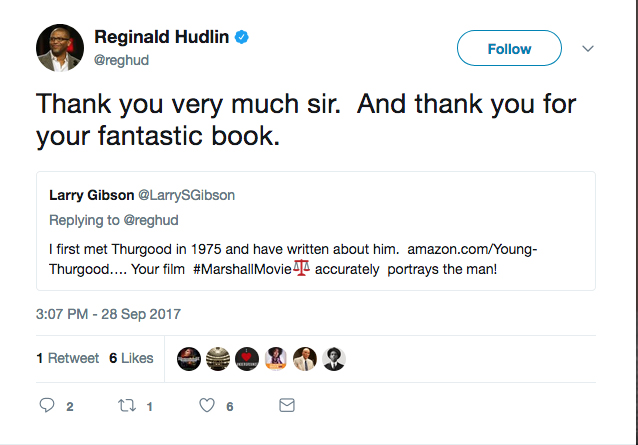It was late July, and University of Maryland Francis King Carey School of Law professor Larry Gibson, LLB, had just attended a pre-release screening of the new movie, Marshall, as part of the NAACP Convention being held in Baltimore.
He approached the film’s star, Chadwick Boseman, who portrays Supreme Court Justice Thurgood Marshall in the film, and its director, Reginald Hudlin. Gibson offered them both copies of his 2012 book, Young Thurgood: The Making of a Supreme Court Justice.
“Before I could even ask anything, they both said, ‘Oh, we read this book,’ and that made me feel so good” Gibson recalls.

"Marshall" director Reginald Hudlin thanked Larry Gibson, LLB, for his book on Thurgood Marshall
“That’s when I humorously said, ‘I didn’t see my name in the credits,’ and one of them said it was research!”
The film, which debuts nationwide Friday, marks the 50th anniversary of Marshall taking his place on the Supreme Court in 1967. He was the first African-American to serve on the court and made his mark as a staunch defender of individual rights.
Marshall graduated from Howard University School of Law magna cum laude in 1933. He was a Baltimore native, but the segregation policies of what was then known as the University of Maryland School of Law prevented him from applying.
In 1935, Marshall successfully sued the law school on behalf of African-American applicant Donald Murray, resulting in a landmark ruling that desegregated the school. The Thurgood Marshall Law Library on campus bears his name.
Even though Gibson’s name is not in the credits, he wholeheartedly supports the film that chronicles Marshall’s early days as a young civil rights attorney defending a black chauffeur (portrayed by Sterling K. Brown) charged with the sexual assault and attempted murder of his white socialite employer (portrayed by Kate Hudson).
Gibson noted in a Twitter exchange to director Reginald Hudlin, “Cecilia Marshall called my book 'the most accurate book every published about my husband' You have now made the most accurate film! Bravo!”
He also has words for critics who say Boseman looks nothing like Thurgood Marshall, who was taller and had lighter skin. “He’s an amazing actor,” says Gibson of Boseman, who also played Jackie Robinson and James Brown in other films.
“This man does a really good job of capturing Thurgood Marshall the person with his speech patterns, body language, attitude. You forget the difference visually within the first few minutes of the movie. That is simply no longer a factor.”
Back in his office, surrounded by law books and personal photos that include the famed Supreme Court justice, Gibson notes that his book and the Marshall film tell the story of a young Thurgood Marshall. The movie “is not about the period that people are most knowledgeable about, either his time on the Supreme Court or his most famous cases like Brown vs. Board of Education,” he says. “This is very early on in his career, this is 1941, and Thurgood Marshall is 33 years old.”
Gibson’s first book Young Thurgood, ends in 1938. He is currently writing another book with the working title Thurgood’s Coming: Mobilizing Civil Rights Activists in the South 1938-1954, which begins when Marshall was starting off as an NAACP attorney and tells the story of how he crisscrossed the South taking on civil rights cases and helping to dismantle Jim Crow laws.
Rather than a chronological timeline, Gibson organized the book on a geographical basis to allow him to retrace Marshall’s steps through the South, beginning in Texas. Gibson will soon embark on a tour of the South to step into Marshall's shoes and get a feel for the small towns where he tried many career-defining cases.
There are plenty of books out there that describe in great detail Marshall’s well-known cases, says Gibson. “My effort in this book is to show more of what he was like than what he did. I try to explain the person."
Coinciding with the movie release, Time also is releasing a special-edition book called Thurgood Marshall: The Visionary, which includes commentary from Gibson and references his first book.


